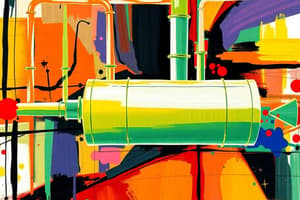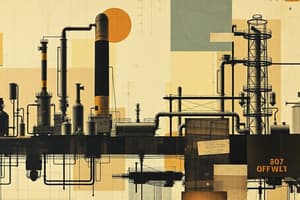Podcast
Questions and Answers
A chemical engineer is tasked with scaling up a chemical production process. Which of the following considerations would require the MOST integrated understanding of multiple core chemical engineering concepts?
A chemical engineer is tasked with scaling up a chemical production process. Which of the following considerations would require the MOST integrated understanding of multiple core chemical engineering concepts?
- Designing a distillation column to separate ethanol from a fermentation broth.
- Optimizing the operating conditions of a catalytic reactor to maximize product yield while minimizing byproduct formation. (correct)
- Implementing a PID control loop to maintain a constant temperature in a stirred tank reactor.
- Selecting a corrosion-resistant alloy for a reactor vessel to prevent material degradation.
In the context of designing a sustainable chemical process, which approach BEST exemplifies a chemical engineer's role in minimizing environmental impact while maintaining economic viability?
In the context of designing a sustainable chemical process, which approach BEST exemplifies a chemical engineer's role in minimizing environmental impact while maintaining economic viability?
- Switching from a batch process to a continuous process to increase production volume.
- Optimizing energy consumption in separation processes by using advanced process control strategies.
- Implementing end-of-pipe treatment technologies to remove pollutants from wastewater streams.
- Utilizing renewable feedstocks and designing reaction pathways with high atom economy to reduce waste generation. (correct)
When designing a chemical reactor, a chemical engineer must consider various factors to optimize the reaction process. Which of the following scenarios requires the MOST complex trade-off analysis?
When designing a chemical reactor, a chemical engineer must consider various factors to optimize the reaction process. Which of the following scenarios requires the MOST complex trade-off analysis?
- Selecting the appropriate type of impeller for mixing reactants in a stirred tank reactor.
- Determining the optimal catalyst particle size to balance reaction rate and pressure drop in a packed bed reactor. (correct)
- Calculating the heat duty required to maintain the reactor at a specific temperature.
- Choosing the right material of construction for the reactor to withstand corrosive chemicals.
A chemical engineer is tasked with improving the efficiency of a distillation column separating azeotropic mixture. Which strategy would require the MOST innovative approach, pushing the boundaries of traditional separation techniques?
A chemical engineer is tasked with improving the efficiency of a distillation column separating azeotropic mixture. Which strategy would require the MOST innovative approach, pushing the boundaries of traditional separation techniques?
In the design of a novel membrane separation process for gas purification, which factor presents the GREATEST challenge in terms of long-term performance and economic viability?
In the design of a novel membrane separation process for gas purification, which factor presents the GREATEST challenge in terms of long-term performance and economic viability?
A chemical engineer is designing a process for producing a pharmaceutical compound. The reaction involves multiple steps with complex kinetics and unstable intermediates. Which approach would be the MOST critical for ensuring consistent product quality and process safety?
A chemical engineer is designing a process for producing a pharmaceutical compound. The reaction involves multiple steps with complex kinetics and unstable intermediates. Which approach would be the MOST critical for ensuring consistent product quality and process safety?
When evaluating the feasibility of implementing a novel chemical process, what aspect typically poses the MOST significant hurdle in transitioning from laboratory-scale success to large-scale industrial application?
When evaluating the feasibility of implementing a novel chemical process, what aspect typically poses the MOST significant hurdle in transitioning from laboratory-scale success to large-scale industrial application?
In the context of chemical reaction engineering, what scenario presents the MOST significant challenge in accurately modeling and predicting reactor performance?
In the context of chemical reaction engineering, what scenario presents the MOST significant challenge in accurately modeling and predicting reactor performance?
Which scenario best exemplifies the application of feedforward control in a chemical process?
Which scenario best exemplifies the application of feedforward control in a chemical process?
In the context of chemical reaction engineering, how does the space time ($\tau$) relate to the performance of a chemical reactor, particularly when comparing a Continuous Stirred-Tank Reactor (CSTR) and a Plug Flow Reactor (PFR) for a first-order irreversible reaction?
In the context of chemical reaction engineering, how does the space time ($\tau$) relate to the performance of a chemical reactor, particularly when comparing a Continuous Stirred-Tank Reactor (CSTR) and a Plug Flow Reactor (PFR) for a first-order irreversible reaction?
Which of the following scenarios would necessitate a comprehensive Process Hazard Analysis (PHA) according to established safety protocols?
Which of the following scenarios would necessitate a comprehensive Process Hazard Analysis (PHA) according to established safety protocols?
How does the implementation of green chemistry principles specifically address the reduction of environmental impact in a chemical manufacturing process?
How does the implementation of green chemistry principles specifically address the reduction of environmental impact in a chemical manufacturing process?
In the design of a shell and tube heat exchanger, what is the MOST critical consideration when selecting the tube diameter and tube layout (e.g., triangular, square) to optimize heat transfer and minimize fouling, especially when handling fluids with high fouling potential?
In the design of a shell and tube heat exchanger, what is the MOST critical consideration when selecting the tube diameter and tube layout (e.g., triangular, square) to optimize heat transfer and minimize fouling, especially when handling fluids with high fouling potential?
Which of the following scenarios would MOST likely require the application of computational fluid dynamics (CFD) for effective analysis and design?
Which of the following scenarios would MOST likely require the application of computational fluid dynamics (CFD) for effective analysis and design?
When designing a separation process for a mixture containing components with very close boiling points, which separation technique would likely be the MOST energy-efficient and effective?
When designing a separation process for a mixture containing components with very close boiling points, which separation technique would likely be the MOST energy-efficient and effective?
In the context of process control, what is the key advantage of implementing Model Predictive Control (MPC) over traditional PID control for a complex chemical process with multiple interacting control loops and constraints?
In the context of process control, what is the key advantage of implementing Model Predictive Control (MPC) over traditional PID control for a complex chemical process with multiple interacting control loops and constraints?
In the context of sustainable chemical engineering, how does Life Cycle Assessment (LCA) contribute to the development of more environmentally responsible processes and products?
In the context of sustainable chemical engineering, how does Life Cycle Assessment (LCA) contribute to the development of more environmentally responsible processes and products?
How does the application of artificial intelligence (AI) and machine learning (ML) specifically enhance process intensification efforts in chemical engineering?
How does the application of artificial intelligence (AI) and machine learning (ML) specifically enhance process intensification efforts in chemical engineering?
Flashcards
Chemical Engineering
Chemical Engineering
Applies sciences, math, and economics to produce, transform, transport, and use chemicals, materials, and energy.
Process Engineering
Process Engineering
Designing, operating, controlling, and optimizing chemical and related processes.
Transport Phenomena
Transport Phenomena
Fluid mechanics, heat transfer, and mass transfer.
Thermodynamics
Thermodynamics
Signup and view all the flashcards
Reaction Engineering
Reaction Engineering
Signup and view all the flashcards
Distillation
Distillation
Signup and view all the flashcards
Absorption
Absorption
Signup and view all the flashcards
Extraction
Extraction
Signup and view all the flashcards
Batch Reactor
Batch Reactor
Signup and view all the flashcards
CSTR (Continuous Stirred-Tank Reactor)
CSTR (Continuous Stirred-Tank Reactor)
Signup and view all the flashcards
Plug Flow Reactor (PFR)
Plug Flow Reactor (PFR)
Signup and view all the flashcards
First Law of Thermodynamics
First Law of Thermodynamics
Signup and view all the flashcards
Second Law of Thermodynamics
Second Law of Thermodynamics
Signup and view all the flashcards
Conduction
Conduction
Signup and view all the flashcards
Convection
Convection
Signup and view all the flashcards
Process Control
Process Control
Signup and view all the flashcards
Feedforward Control
Feedforward Control
Signup and view all the flashcards
Study Notes
- Chemical engineering is a branch of engineering that applies physical sciences (physics and chemistry), life sciences (biology, microbiology and biochemistry), together with applied mathematics and economics to produce, transform, transport, and use chemicals, materials, and energy.
Core Concepts
- Chemical engineers design and operate processes to convert raw materials into valuable products.
- They focus on process design, operation, control, optimization, and equipment design for chemical and related processes.
- Transport phenomena (fluid mechanics, heat transfer, mass transfer) are fundamental to chemical engineering.
- Thermodynamics, kinetics, and separation technologies are essential concepts.
- Chemical reaction engineering is important for designing and optimizing chemical reactors.
Key Areas of Focus
- Process design and optimization: Developing efficient and safe chemical processes.
- Reaction engineering: Designing and analyzing chemical reactors.
- Transport phenomena: Understanding and applying principles of fluid mechanics, heat transfer, and mass transfer.
- Thermodynamics: Applying thermodynamic principles to chemical processes.
- Separation processes: Designing and operating separation equipment (distillation, extraction, absorption, etc.).
- Process control: Maintaining stable and efficient operation of chemical plants.
- Materials science: Selecting appropriate materials for process equipment.
- Safety: Ensuring the safe operation of chemical plants and processes.
- Sustainability: Developing environmentally friendly and sustainable processes.
Unit Operations
- Distillation: Separating components of a liquid mixture based on boiling points.
- Absorption: Removing a component from a gas stream by dissolving it in a liquid.
- Extraction: Separating components of a mixture by using a solvent.
- Filtration: Separating solids from liquids using a filter medium.
- Drying: Removing moisture from a solid material.
- Evaporation: Vaporizing a liquid.
- Crystallization: Forming solid crystals from a solution or melt.
- Membrane separation: Using semi-permeable membranes to separate components.
Chemical Reactions
- Chemical reactions involve the rearrangement of atoms and molecules.
- Reaction rates depend on temperature, pressure, and concentrations of reactants.
- Catalysts can accelerate reaction rates without being consumed in the reaction.
- Chemical equilibrium describes the state where the rates of forward and reverse reactions are equal.
- Reaction kinetics studies the rates and mechanisms of chemical reactions.
- Reactor types include batch reactors, continuous stirred-tank reactors (CSTRs), and plug flow reactors (PFRs).
Thermodynamics
- Thermodynamics deals with energy and its transformations.
- The first law of thermodynamics states that energy is conserved.
- The second law of thermodynamics states that entropy of an isolated system tends to increase.
- Enthalpy is a thermodynamic property that represents the total heat content of a system.
- Gibbs free energy is a thermodynamic potential that determines the spontaneity of a process.
- Phase equilibrium describes the conditions under which different phases coexist in equilibrium.
Transport Phenomena
- Fluid mechanics deals with the behavior of fluids (liquids and gases).
- Heat transfer deals that the transfer of thermal energy.
- Mass transfer deals with the transport of mass.
- Viscosity is a measure of a fluid's resistance to flow.
- Conduction is heat transfer through a solid material.
- Convection is heat transfer by the movement of fluids.
- Radiation is heat transfer through electromagnetic waves.
- Diffusion is the movement of molecules from a region of high concentration to a region of low concentration.
Process Control
- Process control involves maintaining stable and efficient operation of chemical plants.
- Process variables (temperature, pressure, flow rate, etc.) are measured and controlled.
- Control loops consist of sensors, controllers, and actuators.
- Feedback control uses measurements to adjust process variables.
- Feedforward control anticipates disturbances and adjusts process variables accordingly.
- Common control strategies include PID control (proportional-integral-derivative control).
Separation Processes
- Separation processes are used to separate components of a mixture.
- Distillation separates components based on boiling points.
- Extraction separates components based on solubility in a solvent.
- Absorption removes a component from a gas stream by dissolving it in a liquid.
- Membrane separation uses semi-permeable membranes to separate components.
- Adsorption separates components by selectively adsorbing them onto a solid surface.
Equipment Design
- Chemical engineers design and specify equipment for chemical plants.
- Equipment includes reactors, heat exchangers, pumps, compressors, and separation equipment.
- Equipment design considers factors such as safety, cost, and performance.
- Material selection is important for ensuring equipment durability and compatibility with process fluids.
- Codes and standards (e.g., ASME, API) provide guidelines for equipment design and fabrication.
Safety and Ethics
- Safety is a paramount concern in chemical engineering.
- Chemical engineers must design and operate plants safely to protect workers and the public.
- Process hazard analysis (PHA) is used to identify and assess potential hazards.
- Layers of protection (e.g., safety interlocks, relief valves) are used to prevent accidents.
- Ethical considerations are important in chemical engineering practice.
- Chemical engineers must act responsibly and protect the environment and public health.
Sustainability
- Sustainability is an increasingly important consideration in chemical engineering.
- Chemical engineers are developing more environmentally friendly and sustainable processes.
- Green chemistry principles aim to reduce or eliminate the use of hazardous substances.
- Waste minimization and recycling are important for reducing environmental impact.
- Renewable energy sources are being used to power chemical plants.
- Life cycle assessment (LCA) is used to evaluate the environmental impact of a product or process.
Applications
- Chemical engineering principles are applied in a wide range of industries.
- Petroleum refining: Converting crude oil into fuels and chemicals.
- Petrochemicals: Producing chemicals from petroleum feedstocks.
- Pharmaceuticals: Manufacturing drugs and pharmaceuticals.
- Food processing: Processing and packaging food products.
- Polymers: Producing plastics and other polymeric materials.
- Biotechnology: Using biological systems to produce chemicals and materials.
- Environmental engineering: Developing solutions to environmental problems.
- Microelectronics: Manufacturing integrated circuits and other microelectronic devices.
Emerging Areas
- Systems biology: Applying engineering principles to biological systems.
- Nanotechnology: Designing and manufacturing materials at the nanoscale.
- Sustainable engineering: Developing environmentally friendly and sustainable processes.
- Biofuels: Producing fuels from renewable biomass sources.
- Artificial intelligence and machine learning: Applying AI and ML to chemical engineering problems.
- Process intensification: Developing more compact and efficient chemical processes.
Studying That Suits You
Use AI to generate personalized quizzes and flashcards to suit your learning preferences.




